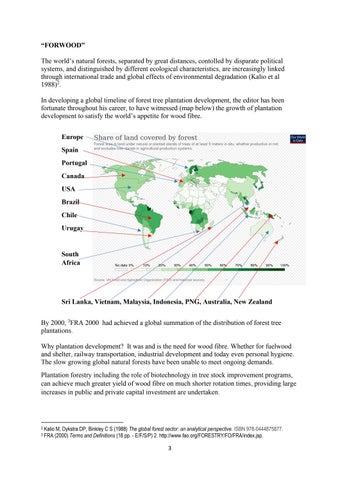“FORWOOD” The world’s natural forests, separated by great distances, contolled by disparate political systems, and distinguished by different ecological characteristics, are increasingly linked through international trade and global effects of environmental degradation (Kalio et al 1988)2. In developing a global timeline of forest tree plantation development, the editor has been fortunate throughout his career, to have witnessed (map below) the growth of plantation development to satisfy the world’s appetite for wood fibre. Europe Spain Portugal Canada USA Brazil Chile Urugay
South Africa
Sri Lanka, Vietnam, Malaysia, Indonesia, PNG, Australia, New Zealand By 2000, 3FRA 2000 had achieved a global summation of the distribution of forest tree plantations. Why plantation development? It was and is the need for wood fibre. Whether for fuelwood and shelter, railway transportation, industrial development and today even personal hygiene. The slow growing global natural forests have been unable to meet ongoing demands. Plantation forestry including the role of biotechnology in tree stock improvement programs, can achieve much greater yield of wood fibre on much shorter rotation times, providing large increases in public and private capital investment are undertaken.
2 3
Kalio M, Dykstra DP, Binkley C S (1988) The global forest sector: an analytical perspective. ISBN 978-0444875877. FRA (2000) Terms and Definitions (18 pp. - E/F/S/P) 2. http://www.fao.org/FORESTRY/FO/FRA/index.jsp.
3
















